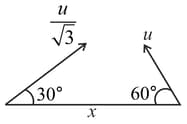EASY
NEET
IMPORTANT
Earn 100
A river is flowing at the rate of . A swimmer swims across the river with a velocity of with respect to water. The resultant velocity of the man will be in :-
(a)
(b)
(c)
(d)
50% studentsanswered this correctly

Important Questions on Kinematics
MEDIUM
NEET
IMPORTANT
A man wishes to swim across a river wide. If he can swim at the rate of in still water and the river flows at the rate of . The angle made by the direction (with respect to the flow of the river) along which he should swim to reach a point exactly opposite his starting point, should be
MEDIUM
NEET
IMPORTANT
A boat-man can row a boat to make it move at a speed of , in still water. The river flows steadily at the rate of , and the width of the river is . If the boat-man to across the river along with the minimum distance of approach then the time elapsed in rowing the boat will be:
EASY
NEET
IMPORTANT
A bird is flying towards the south with a velocity and a train is moving with a velocity towards the east. What is the velocity of the bird with respect to an observer on the train?
EASY
NEET
IMPORTANT
A bird is flying at a speed of in the north direction. A train is moving at a speed of in the west direction. A passenger sitting in the train will see the bird moving with velocity:
EASY
NEET
IMPORTANT
A particle is moving with a velocity of towards the east. After its velocity changes to towards north. Its average acceleration is
EASY
NEET
IMPORTANT
A man is walking on a road with a velocity of when suddenly, it starts raining velocity of rain is in a vertically downward direction, the relative velocity of the rain with respect to man is:
EASY
NEET
IMPORTANT
Two particles are separated by a horizontal distance as shown in the figure. They are projected as shown in the figure with different initial speeds. The time after which the horizontal distance between them becomes zero is:

MEDIUM
NEET
IMPORTANT
Let and represent the positions of particles and , respectively, as functions of time ; and are in and is in . The relative speed of the two particles at the instant , will be
